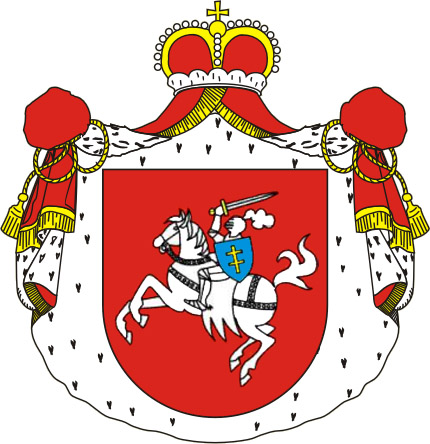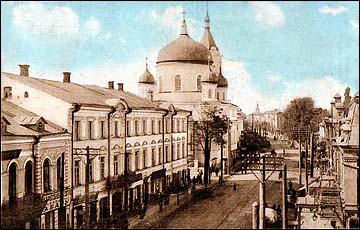|
Aleksander Franciszek Chodkiewicz
Count Aleksander Franciszek Chodkiewicz (4 June 1776, Chernobyl - 24 January 1838, Młynów) was a Polish writer, playwright, chemist, lithographer, patron of the arts, collector, military officer and politician. Biography He was the son of Count Jan Mikołaj Chodkiewicz, the Starost of Żmudź, and his wife, Maria Ludwika Rzewuska (1744–1816), daughter of the poet and Hetman, Wacław Rzewuski. He originally studied at home then, after 1790, attended a private boarding school for the nobility. He took part in the Kościuszko Uprising, becoming a Major in the National Guard. When the uprising failed, he settled in Volhynia, devoting himself to scientific and literary work, as his estates had been sequestered. Tadeusz Estreicher and Henryk Mościcki, "Chodkiewicz Aleksander (1776–1838) generał, literat, technolog", in: ''Polski Słownik Biograficzny'', Kraków: 1937, pp.355–358 He was a member of the Sejm in 1809. During the Austro-Polish War, he organized secret patriot ... [...More Info...] [...Related Items...] OR: [Wikipedia] [Google] [Baidu] |
Lithuanian Provisional Governing Commission
The Provisional Government Commission of the Grand Duchy of Lithuania; also, the Lithuanian Provisional Governing Commission (Polish: ''Komisja Rządu Tymczasowego Wielkiego Księstwa Litewskiego''; also ''Komisja Rządząca Tymczasowa Litewska''; French: ''le Gouvernement provisoire de Lituanie''; also ''Gouvernement général de la Lituanie'', Lithuanian ''Lietuvos laikinosios vyriausybės komisija'') was a provisional administrative body for the Grand Duchy of Lithuania, which had been overtaken by Napoleon's Grand Army during the 1812 French invasion of Russia. On 14 July 1812 the Commission formally joined the General Confederation of the Kingdom of Poland, creating the united Kingdom of Poland. History The Commission was established on 1 July 1812 by order of French Emperor Napoleon Bonaparte. Its chief tasks included the creation of Lithuanian armed forces, and the provisioning of Napoleon's troops. The provinces of Vilnius, Grodno, Minsk and Białystok were attached to th ... [...More Info...] [...Related Items...] OR: [Wikipedia] [Google] [Baidu] |
Józef Oleszkiewicz
Józef Oleszkiewicz ( lt, Juozapas Oleškevičius, russian: Юзеф Иванович Олешкевич; c.1777, in Šiluva – 5 October 1830, in Saint Petersburg) was a Polish-Lithuanian painter, known primarily for his portraits and his eccentric behavior. Biography Oleszkiewicz came from an impoverished noble family; his father was a musician. With assistance from a family friend, he became a student at the University of Vilnius in 1797. He studied anatomy and physiology but switched to drawing and painting, taking classes with Franciszek Smuglewicz and Jan Rustem.Biography @ Žemaitija. He also copied paintings at the homes of wealthy people who knew his family. In 1801, he attracted the attention of Count |
Antoni Andrzejowski
Antoni Lukianowicz Andrzejowski (also Anton and Andrzeiovski, Andrzeiowski, Andrzeiowsky, russian: Антон Лукьянович Андржейовский, Anton Lukjanowitsch Andrschejowski) was a Russian-Polish botanist, zoologist and paleontologist. He also used the pseudonym Stary Detiuk, meaning "old Detiuk". Early life and education Andrzejowski was born the son of a bank clerk and property manager in the village of in the present-day Rivne Oblast in Ukraine. He grew up in various places in western Ukraine and studied in Vilnius after his father's death in 1801. Andrzejowski was a student of the botanists Franz Scheidt and Wilibald Swibert Joseph Gottlieb von Besser in Kremenets. Career in botany Andrzejowski was a teacher at the lyceum in Kremenets. After his Polish-language lyceum was dissolved in 1832, he was an assistant to Wilibald Swibert Joseph Gottlieb von Besser and lecturer at Kiev University beginning in 1832. He had to give up that position when the Russi ... [...More Info...] [...Related Items...] OR: [Wikipedia] [Google] [Baidu] |
Eastern Orthodox Church
The Eastern Orthodox Church, also called the Orthodox Church, is the second-largest Christian church, with approximately 220 million baptized members. It operates as a communion of autocephalous churches, each governed by its bishops via local synods. The church has no central doctrinal or governmental authority analogous to the head of the Roman Catholic Church—the Pope—but the Ecumenical Patriarch of Constantinople is recognized by them as '' primus inter pares'' ("first among equals"), which may be explained as a representative of the church. As one of the oldest surviving religious institutions in the world, the Eastern Orthodox Church has played a prominent role in the history and culture of Eastern and Southeastern Europe. The Eastern Orthodox Church officially calls itself the Orthodox Catholic Church. Eastern Orthodox theology is based on holy tradition, which incorporates the dogmatic decrees of the seven ecumenical councils, the Scriptures, and the teachin ... [...More Info...] [...Related Items...] OR: [Wikipedia] [Google] [Baidu] |
November Uprising
The November Uprising (1830–31), also known as the Polish–Russian War 1830–31 or the Cadet Revolution, was an armed rebellion in the heartland of partitioned Poland against the Russian Empire. The uprising began on 29 November 1830 in Warsaw when young Polish officers from the military academy of the Army of Congress Poland revolted, led by Lieutenant Piotr Wysocki. Large segments of the peoples of Lithuania, Belarus, and the Right-bank Ukraine soon joined the uprising. Although the insurgents achieved local successes, a numerically superior Imperial Russian Army under Ivan Paskevich eventually crushed the uprising. "Polish Uprising of 1830–31." ''The Great Soviet Encyclopedia'', 3rd Edition (1970–1979). G ... [...More Info...] [...Related Items...] OR: [Wikipedia] [Google] [Baidu] |
Żytomierz
Zhytomyr ( uk, Жито́мир, translit=Zhytomyr ; russian: Жито́мир, Zhitomir ; pl, Żytomierz ; yi, זשיטאָמיר, Zhitomir; german: Schytomyr ) is a city in the north of the western half of Ukraine. It is the Capital city, administrative center of Zhytomyr Oblast (Oblast, province), as well as the administrative center of the surrounding Zhytomyr Raion (Raion, district). The city of Zhytomyr is not a part of Zhytomyr Raion: the city itself is designated as its own separate raion within the oblast; moreover Zhytomyr consists of two so-called "raions in a city": Bohunskyi Raion and Koroliovskyi Raion (named in honour of Sergey Korolyov). Zhytomyr occupies an area of . Its population is Zhytomyr is a major transport hub. The city lies on a historic route linking the city of Kyiv with the west through Brest, Belarus, Brest. Today it links Warsaw with Kyiv, Minsk with Izmail, and several major cities of Ukraine. Zhytomyr was also the location of Ozerne (air base) ... [...More Info...] [...Related Items...] OR: [Wikipedia] [Google] [Baidu] |
Sandomierz
Sandomierz (pronounced: ; la, Sandomiria) is a historic town in south-eastern Poland with 23,863 inhabitants (as of 2017), situated on the Vistula River in the Sandomierz Basin. It has been part of Świętokrzyskie Voivodeship (Holy Cross Province) since 1999, having previously been located in the Tarnobrzeg Voivodeship. It is the capital of Sandomierz County. Sandomierz is known for its preserved Old Town, a major cultural and tourist attraction which was declared a National Monument of Poland in 2017. In the past, Sandomierz used to be one of the most important urban centers not only of Lesser Poland, but also of the whole country. It was a royal city of the Polish Crown and a regional administrative centre from the High Middle Ages to the 19th century. Etymology The name of the city might have originated from the Old Polish ', composed of ' (from the verb ' "to judge") and ' ("peace"), or more likely from the antiquated given name Sędzimir, once popular in several Slavi ... [...More Info...] [...Related Items...] OR: [Wikipedia] [Google] [Baidu] |
Grand Duke Konstantin Pavlovich Of Russia
Konstantin Pavlovich (russian: Константи́н Па́влович; ) was a grand duke of Russia and the second son of Emperor Paul I and Sophie Dorothea of Württemberg. He was the heir-presumptive for most of his elder brother Alexander I's reign, but had secretly renounced his claim to the throne in 1823. For 25 days after the death of Alexander I, from 19 November (O.S.)/1 December 1825 to 14 December (O.S.)/26 December 1825 he was known as ''His Imperial Majesty Konstantin I Emperor and Sovereign of Russia'', although he never reigned and never acceded to the throne. His younger brother Nicholas became Tsar in 1825. The succession controversy became the pretext of the Decembrist revolt. Konstantin was known to eschew court etiquette and to take frequent stands against the wishes of his brother Alexander I, for which he is remembered fondly in Russia, but in his capacity as the governor of Poland he is remembered as a hated ruler. Early life Konstantin was born i ... [...More Info...] [...Related Items...] OR: [Wikipedia] [Google] [Baidu] |
Congress Poland
Congress Poland, Congress Kingdom of Poland, or Russian Poland, formally known as the Kingdom of Poland, was a polity created in 1815 by the Congress of Vienna as a semi-autonomous Polish state, a successor to Napoleon's Duchy of Warsaw. It was established when the French ceded a part of Polish territory to the Russian Empire following France's defeat in the Napoleonic Wars. In 1915, during World War I, it was replaced by the German-controlled nominal Regency Kingdom until Poland regained independence in 1918. Following the partitions of Poland at the end of the 18th century, Poland ceased to exist as an independent nation for 123 years. The territory, with its native population, was split between the Habsburg monarchy, the Kingdom of Prussia, and the Russian Empire. After 1804, an equivalent to Congress Poland within the Austrian Empire was the Kingdom of Galicia and Lodomeria, also commonly referred to as "Austrian Poland". The area incorporated into Prussia and subse ... [...More Info...] [...Related Items...] OR: [Wikipedia] [Google] [Baidu] |
Brigadier-General
Brigadier general or Brigade general is a military rank used in many countries. It is the lowest ranking general officer in some countries. The rank is usually above a colonel, and below a major general or divisional general. When appointed to a field command, a brigadier general is typically in command of a brigade consisting of around 4,000 troops (four battalions). Variants Brigadier general Brigadier general (Brig. Gen.) is a military rank used in many countries. It is the lowest ranking general officer in some countries, usually sitting between the ranks of colonel and major general. When appointed to a field command, a brigadier general is typically in command of a brigade consisting of around 4,000 troops (four battalions). In some countries, this rank is given the name of ''brigadier'', which is usually equivalent to ''brigadier general'' in the armies of nations that use the rank. The rank can be traced back to the militaries of Europe where a "brigadier general ... [...More Info...] [...Related Items...] OR: [Wikipedia] [Google] [Baidu] |






.jpg)
